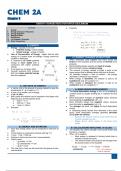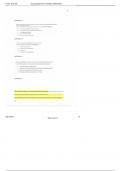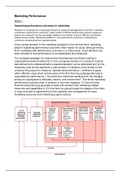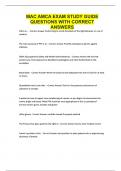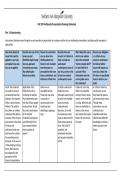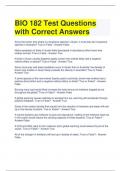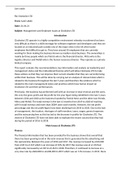2024
Summary Procurement
& Supply Management
COMPLETE SUMMARY
, Lectures Procurement & Supply Management
Week 1
Lecture 1
Market failures and government interventions
Efficiency of perfect markets but markets are not always efficient
Economist analyze this:
Describe behavior of firms and consumers
Implications for public policy
Examples from transport markets
Traffic congestion
A growth trend over the years
Traffic and travel time loss increase growing economy and lower
oil price
Concentration of size and growth in the Netherlands
Certain timeframes are extremely busy traffic is concentrated in
overpopulated places and on certain times
Conclusion traffic congestion
Average is no problem but due to concentration it is market fails
Economic approach
Road is a market
Demand trips
Supply highway capacity
Value of Time (VoT)
Important part of the price for a trip
Economic example traffic
Standard inverse demand function D
Price is a generalized price, for which time is important especially
when talking congestion
Area below D gives B
D itself gives mb benefits attached to the last trip added
Supply side
Travel time rises when demand increases
Average costs (= generalized price) also rises
ac = travel time + VoT + other costs
Area G = possible welfare gain
From N0 to N*
Benefits fall with area below D = mb
Costs fall with area below mc
External costs
, Unpriced costs imposed on others (environmental pollution or
noise)
Marginal external costs mec value of travel time losses caused for
others by last trip added
mec = mc – ac
free market outcome not efficient social surplus S = B – C not
maximized
optimum
goal reduce road use from 45 to 30
economic solution demand should fall? Price should rise
road pricing (r) generalized price becomes ac + r
optimal toll r* = mec (N*)
r* = mec
Every road user pays a toll equal to the external costs he creates for
others
Congestion is optimized not minimized
Toll varies during peak hours and off-peak hours
Toll is optimal
Realizes optimal level of road use
Realizes optimal composition of road users
Conclusion
External effect free market is not efficient & pricing restores
efficiency
Pricing is inherently more efficient than non-pricing volume and
composition
Because of distributional impacts, welfare improvements may not
always be easy to implement
Lecture 2
Market power
Exists when a firm is large enough (relative to the market) to face a
downward sloping demand function
Price setting is possible
Monopoly, oligopoly or monopolistic competition
Causes of market power
Economies of scale
Falling average costs when production expands (due to large
fixed costs)
Bigger firms are more efficient and competitive
In transport bigger aircraft / trains / higher frequencies
Economies of scope
As economies of scale, but then when multiple products are
offered by a single firm
In transport network effects
, Network economies
Trains
Hub & spoke
Government policies
Restricted entry
Instable markets, wasteful competition, price wars and destructive
competition
Example: Bertrand competition
Demand P 100 Q = 100 or P > 100 Q = 0
Cost per firm: 1000 + 10*Q
Duopoly with price competition supplier with lowest price gets
whole market, with equal prices both get 50%
Find equilibrium by testing 2 possible deviations of a price equal to
that of the competitor, p:
From p to p+1cent output from 50 to 0 & profit falls with
50*(p-10) don’t do it if p>10, otherwise do
From p to p-1cent output from 50 to 100 & profit rises with
50*(p-1ct-10)-50*1ct do if p>10.01, otherwise don’t
Equilibrium rounded P =10, Q =50
Profit per firm = -1000 loss
Bertrand illustrates
Instable markets both loss 1 bankrupt monopoly entry
both loss etc.
Wasteful competition two firms fixed costs twice
Price wars competition with p=mc leads to losses
Destructive pricing could occur: p<mc to quickly knock out
opponent
All four may motivate government intervention
Causes of market power
Economies of scale and/or scope
Sometimes also government policies (fear of wasteful or destructive
competition)
Consequence 1 from Market power: Price setting
Demand function gives for every quantity the price we can charge
Gives the average revenue
From average revenue to marginal revenue first go to total
revenue
Example D =100 -N
Total revenue R = 100*N -N2
Marginal revenue mr = 100 – 2N
mr is below D to sell one more product, we have to lower the price
we get price P as revenue for last unit sold
we get lower revenues for all other units
Summary Procurement
& Supply Management
COMPLETE SUMMARY
, Lectures Procurement & Supply Management
Week 1
Lecture 1
Market failures and government interventions
Efficiency of perfect markets but markets are not always efficient
Economist analyze this:
Describe behavior of firms and consumers
Implications for public policy
Examples from transport markets
Traffic congestion
A growth trend over the years
Traffic and travel time loss increase growing economy and lower
oil price
Concentration of size and growth in the Netherlands
Certain timeframes are extremely busy traffic is concentrated in
overpopulated places and on certain times
Conclusion traffic congestion
Average is no problem but due to concentration it is market fails
Economic approach
Road is a market
Demand trips
Supply highway capacity
Value of Time (VoT)
Important part of the price for a trip
Economic example traffic
Standard inverse demand function D
Price is a generalized price, for which time is important especially
when talking congestion
Area below D gives B
D itself gives mb benefits attached to the last trip added
Supply side
Travel time rises when demand increases
Average costs (= generalized price) also rises
ac = travel time + VoT + other costs
Area G = possible welfare gain
From N0 to N*
Benefits fall with area below D = mb
Costs fall with area below mc
External costs
, Unpriced costs imposed on others (environmental pollution or
noise)
Marginal external costs mec value of travel time losses caused for
others by last trip added
mec = mc – ac
free market outcome not efficient social surplus S = B – C not
maximized
optimum
goal reduce road use from 45 to 30
economic solution demand should fall? Price should rise
road pricing (r) generalized price becomes ac + r
optimal toll r* = mec (N*)
r* = mec
Every road user pays a toll equal to the external costs he creates for
others
Congestion is optimized not minimized
Toll varies during peak hours and off-peak hours
Toll is optimal
Realizes optimal level of road use
Realizes optimal composition of road users
Conclusion
External effect free market is not efficient & pricing restores
efficiency
Pricing is inherently more efficient than non-pricing volume and
composition
Because of distributional impacts, welfare improvements may not
always be easy to implement
Lecture 2
Market power
Exists when a firm is large enough (relative to the market) to face a
downward sloping demand function
Price setting is possible
Monopoly, oligopoly or monopolistic competition
Causes of market power
Economies of scale
Falling average costs when production expands (due to large
fixed costs)
Bigger firms are more efficient and competitive
In transport bigger aircraft / trains / higher frequencies
Economies of scope
As economies of scale, but then when multiple products are
offered by a single firm
In transport network effects
, Network economies
Trains
Hub & spoke
Government policies
Restricted entry
Instable markets, wasteful competition, price wars and destructive
competition
Example: Bertrand competition
Demand P 100 Q = 100 or P > 100 Q = 0
Cost per firm: 1000 + 10*Q
Duopoly with price competition supplier with lowest price gets
whole market, with equal prices both get 50%
Find equilibrium by testing 2 possible deviations of a price equal to
that of the competitor, p:
From p to p+1cent output from 50 to 0 & profit falls with
50*(p-10) don’t do it if p>10, otherwise do
From p to p-1cent output from 50 to 100 & profit rises with
50*(p-1ct-10)-50*1ct do if p>10.01, otherwise don’t
Equilibrium rounded P =10, Q =50
Profit per firm = -1000 loss
Bertrand illustrates
Instable markets both loss 1 bankrupt monopoly entry
both loss etc.
Wasteful competition two firms fixed costs twice
Price wars competition with p=mc leads to losses
Destructive pricing could occur: p<mc to quickly knock out
opponent
All four may motivate government intervention
Causes of market power
Economies of scale and/or scope
Sometimes also government policies (fear of wasteful or destructive
competition)
Consequence 1 from Market power: Price setting
Demand function gives for every quantity the price we can charge
Gives the average revenue
From average revenue to marginal revenue first go to total
revenue
Example D =100 -N
Total revenue R = 100*N -N2
Marginal revenue mr = 100 – 2N
mr is below D to sell one more product, we have to lower the price
we get price P as revenue for last unit sold
we get lower revenues for all other units


